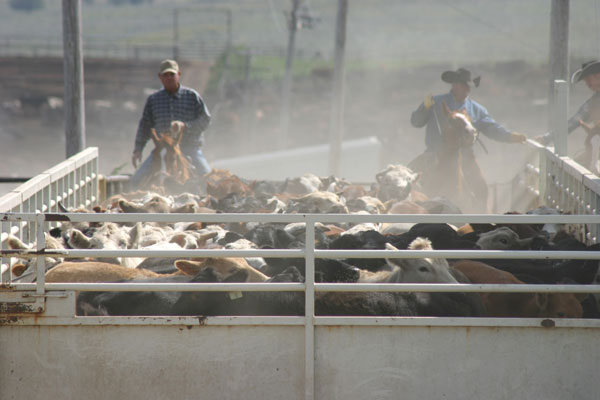January 4, 2016

Just before Christmas, my father-in-law, Scott, was in a farm accident that resulted in a steel corn grate landing on both of his legs. We are thankful he didn’t suffer any nerve damage in his legs and although three months in a cast and several months of physical therapy are in his future, we are confident that by summer, he will be back outside baling hay and looking after his calves.
The New Year’s weekend was spent at my in-law’s house, celebrating a late Christmas and also helping with the cattle and his butchering business. With everyone pitching in, it was a good reminder to cherish your loved ones, and the accident served as a strong warning to remember farm and ranch safety.
Accidents can happen in the blink of an eye, and while some can’t be controlled, others can be avoided if we remember to take certain precautions. I recently read an article in the Ohio State University (OSU) Beef Newsletter that focused on safety tips for working and handling livestock. Written by Rory Lewandowski, OSU Extension educator, here are five tips for reducing risks and avoiding accidents when handling livestock.
1. Understand what your livestock can see, so you know what scares or provokes them.
“Beef, swine and dairy cattle are generally colorblind and have poor depth perception,” says Lewandowski. “These animals are very sensitive to contrasts; explaining why they may balk at shadows, rapid changes from light to dark, or objects hanging from a post or rail. Cattle can’t see objects at the level of their feet without lowering their head. Stepping across a gutter, or into a foot bath can sometimes present a challenge.”
2. Know where the blind spot in cattle is.
“Cattle and horses have a panoramic field of vision, meaning that they can see things all around them in about a 300 degree range without moving their heads,” says Lewandowski. “Their blind spot is immediately behind them. For this reason, approaching directly behind these animals without letting them know you are approaching has more potential for an injury due to kicking than approaching from the side.”
3. Work quietly.
Lewandowski says, “Animal are very sensitive to noise and depending upon their familiarity with a particular noise can be easily frightened or spooked. For this reason, people recognized as good animal handlers commonly say to never work animals using more than a normal, conversational voice volume.”
4. Respect a mama cow’s maternal instinct.
“Most livestock have a maternal instinct with their young that can make them more defensive and more difficult to handle,” he writes.
5. Finally, practice the following when working livestock:
“Most animals will respond to routine; be calm and deliberate,” writes Lewandowski. “Announce your presence well in advance of getting close to an animal, to avoid startling it. Avoid quick movements or loud noises. Be patient; never prod an animal when it has nowhere to go. Move slowly and deliberately around livestock; gently touch animals rather than shoving or bumping them. Always provide yourself with an escape route when working with an animal in close quarters.”
Let’s be safe this winter season. With the snow and ice, calving mamas, and working with heavy machinery, accidents can take just a second. Remember to practice farm and ranch safety to avoid accidents and potential heartache.
The opinions of Amanda Radke are not necessarily those of beefmagazine.com or Penton Agriculture.
You might also like:
7 ranching operations who lead in stewardship, sustainability
Why we need to let Mother Nature select replacement heifers
Photo Gallery: Laugh with Rubes cow cartoons
You May Also Like



